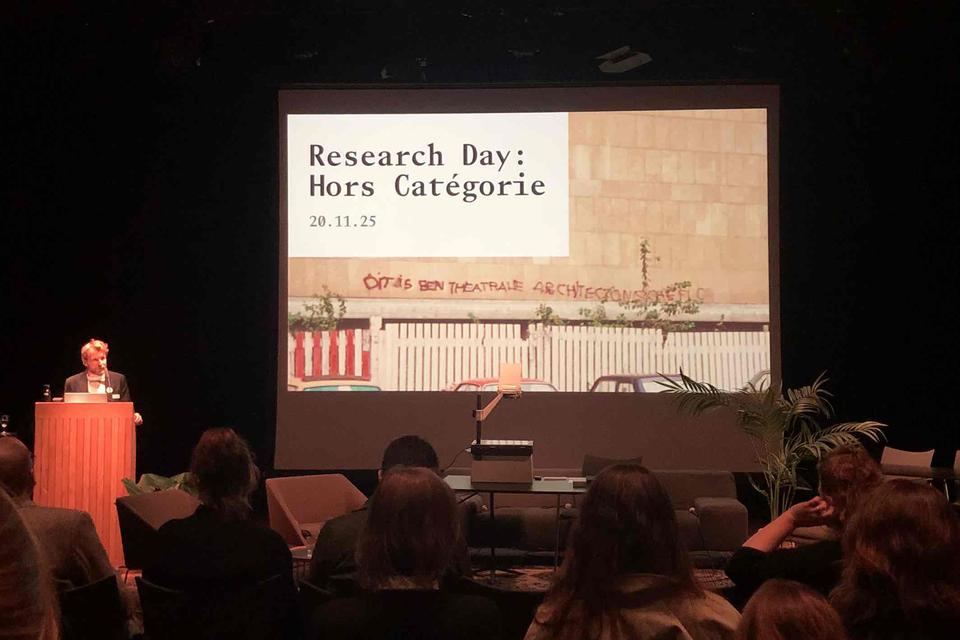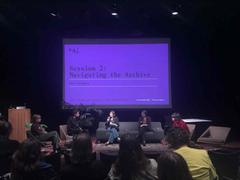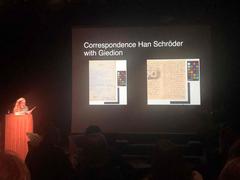Actualités
VAi • RESEARCH DAY 20.11.25 : HORS CATÉGORIE
XXX

TITRAILLE
09.30 – 10.00
Welcome by Dennis Pohl (director of the VAi) and introduction by Janno Martens (researcher at the Knowledge Centre).
10.00 – 10.30
Keynote performance by Pia Jacques : Sticky situations. Living on glue and other cheap materials.
Session 1 : Sourcing the archive, moderated by Tine Poot (Design consultant at the VAi Knowledge Centre).
When we think of design archives, traditional sources like plans, models, and drawings often come to mind. This session, however, explores non-traditional, ephemeral, and digital sources — such as family videos, activist magazines, personal correspondence, social media and even video games. This diversification of source types reflects a broader shift: the very nature of design knowledge is evolving. What kinds of knowledge are being transferred or preserved through these alternative sources ? Who determines what is considered valid, and based on which criteria ? How can we ensure that the sources we use — or generate — represent a plurality of voices and experiences, rather than reinforcing dominant narratives ?
Elodie Degavre (UCLouvain) : “Just ignore the camera”. Revealing processes: the challenging yet rich terrain of family and television archives.
Javier Fernández Contreras (HEAD – Geneva University of Art and Design) : Screens Within Screens: The Architecture of Social Media.
Eline Inghelbreght (KU Leuven) : Counter-Imaginaries of the City: Activist Magazines and Alternative Visual Narratives in Brussels’ Urban Planning (1970s-80s).
Rixt Hoekstra : What source for what history ? The Rietveld-Schröder House from his-story to her-story and the debate on legitimate sources.
13.30 – 15.00
Session 2 : Navigating the archive, moderated by Katrien Weyns (head of VAi Collection).
Every archive, library or collection necessarily relies on systems of registration to make sense of its own contents. Such systems are a precondition for accessibility, allowing archivists, librarians and visitors alike to navigate the endless rows of books and boxes with a certain sense of purpose and precision. In an attempt to ensure this accessibility, institutions rely on international standards such as the ISAD(G) or their own internal conventions, fitting the heterogenous contents of their vaults into a homogenic logic of abstracted organization. Bibliographic classifications such as UDC or DDC even aim at a universal structuring of all human knowledge. Yet, such institutionalized systems also transform the content they represent: the labels, categories and keywords provided to the user might also limit the extent of what can be searched for. How can institutions make room for other ways of navigating their collections? And to what extent is it possible to democratize such institutionalized inventories by enriching them with user-based perspectives ?
Tiphaine Abenia (Université Libre de Bruxelles) : Toward a De-standardized Material Archive: The Sitterwerk Case.
Carole Kojo-Zweifel (CIVA, Brussels) : Thinking, classifying. Finding ? Library classifications in the 21st century.
Stefanie Korrel and Ernst des Bouvrie (Nieuwe Instituut, Rotterdam) : Asterisk*: enriching archives and collections.
15.15 – 16.45
Session 3 : Performing the archive, moderated by Janno Martens (researcher at the VAi Knowledge Centre).
Once design archives are absorbed into institutional collections, they often become detached from the dynamic contexts in which they were originally created. Through this process of institutionalisation, these archives tend to be treated as static resources for research or as artistic material for exhibitions. Whether approached through historical, journalistic, or artistic lenses, research into these collections typically involves a degree of physical and intellectual distance. But what happens when we reverse this approach ? What if, instead of distancing ourselves, we actively seek proximity to the material? This session explores the potential of engaged, embodied, and dynamic interactions with archival collections. Can a more performative and participatory approach to archives reveal new insights—ones that remain hidden in more traditional modes of inquiry ?
Sina Brückner-Amin, Mechthild Ebert (KIT Karlsruhe / saai archive) and Manuela Gantner (commissioned by the Wüstenrot Foundation) : From object to process – and back again: model building as a cycle of architectural insight in the work of Conrad Roland.
Laura Lievevrouw (KU Leuven) and Breg Horemans (KU Leuven / TAAT collective) : On the lost and living gestures of the architect: two perspectives into archiving.
Gjiltinë Isufi (KU Leuven) : Unarchived Therefore Unwritten: Disclosing Microhistories in the Prison of Gjilan, Kosovo.
***
Si "Hors Catégories" était présenté dans le format convenu des journées de communications en forme de colloque, l'idée de divers focus "hors catégories", au travers du triptyque Sourcing - Navigating - Performing the Archive (visuel 1), s'est penché sur les catégories archivistiques qui explosent et se dissolvent... pour la simple raison que l'architecture concerne tout le monde, qu'elle est diffusée par tous les médias et qu'il s'en trouve des traces de toutes sortes dans toutes sortes d'archives, le tout démultiplié parfois de manière exponentielle et pas toujours rigoureuse, via la prolifération d'hyperliens, ce qui renvoie à l'aura des sources primaires, souvent ravalées au rang de cas particulier à ne consulter qu'en cas limite, si le déracinement numérique devient gênant. La déterritorialisation des preuves initiales aux fondements de l'historiographie incite à suivre le trajet Sourcing - Navigating - Performing the Archive pour y déceler les pépites d'une matière instable parce qu'en expansion et parce qu'opérée de manières de plus en plus diverses, avec prolifération d'informations subséquentes, en observant ce qu'éclaire le trajet inverse, à savoir Performing - Navigating - Sourcing the Archive.
§1
Elodie Degavre
Javier Fernández Contreras
Eline Inghelbreght
Rixt Hoekstra
Dénicher des perles rares ou inspecter les proliférations en ligne ? Dans les deux cas, déjouer l’enfouissement par l’infobésité.
§2
Tiphaine Abenia
Carole Kojo-Zweifel
Stefanie Korrel and Ernst des Bouvrie
§3
Sina Brückner-Amin, Mechthild Ebert
Laura Lievevrouw and Breg Horemans
Gjiltinë Isufi
Illustrations



